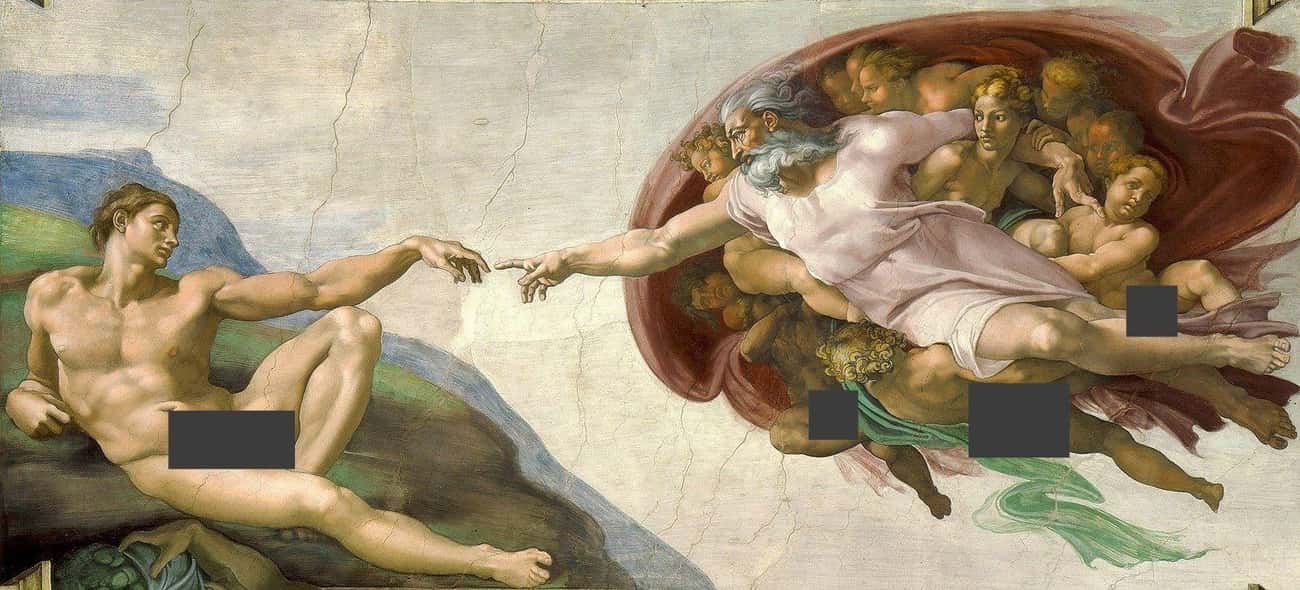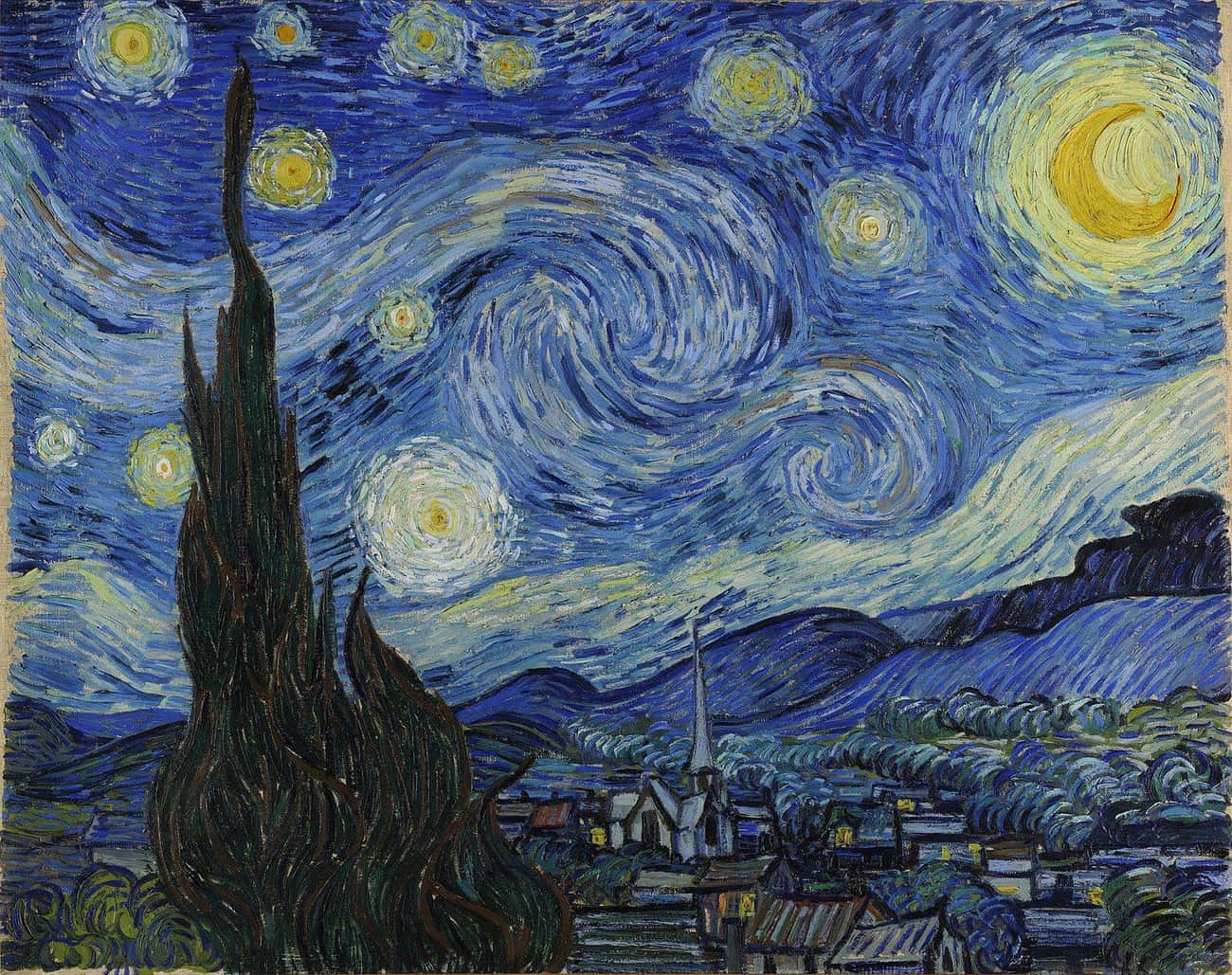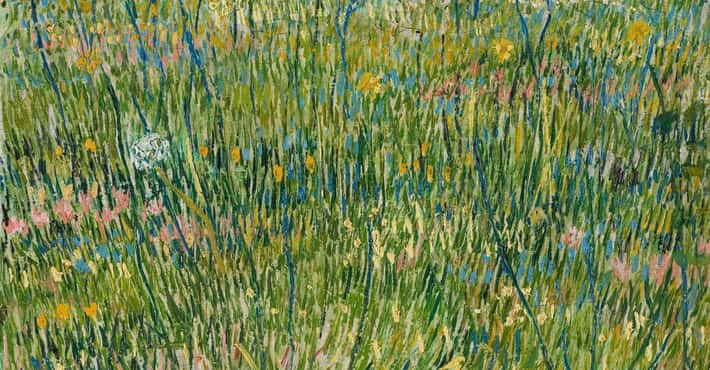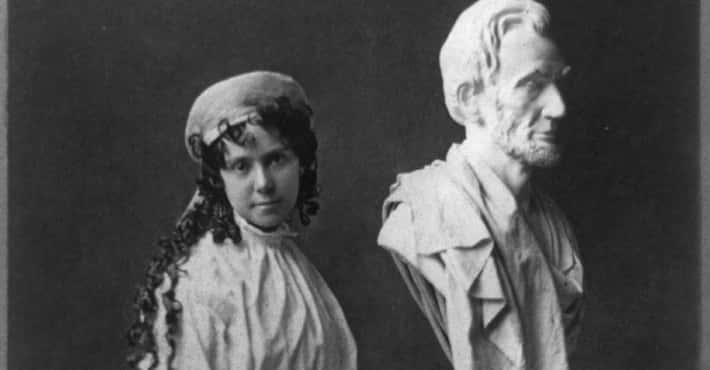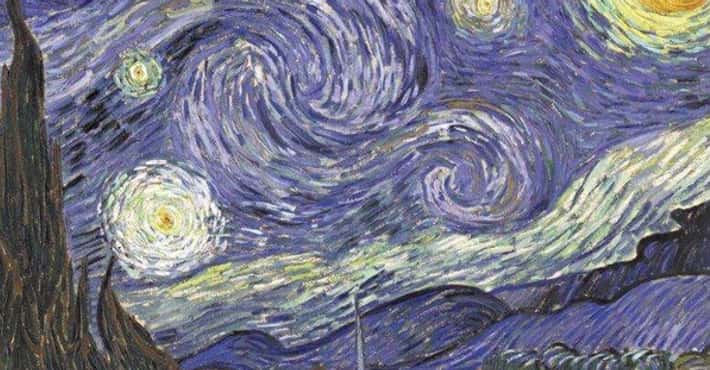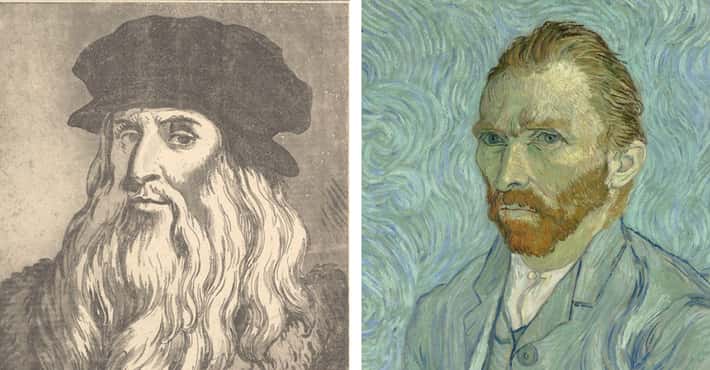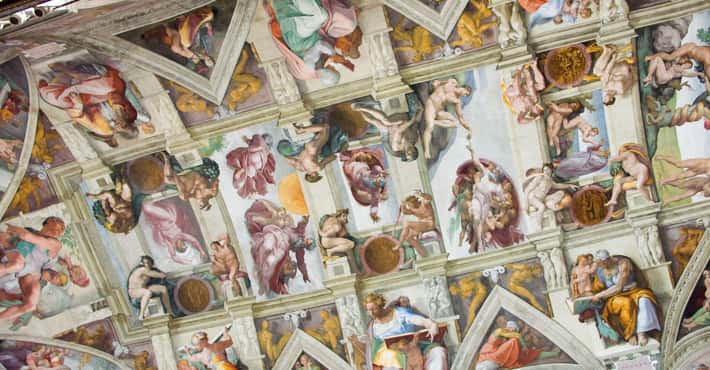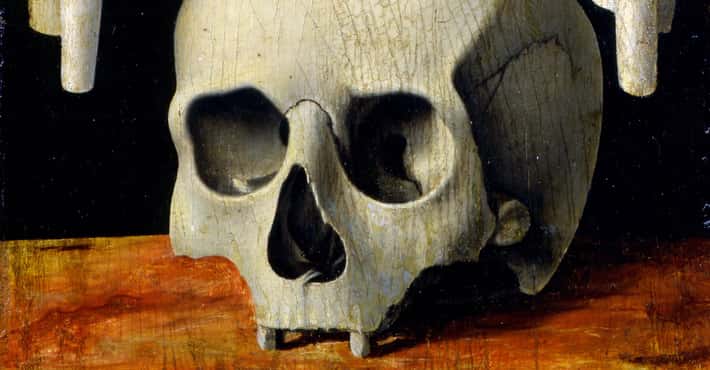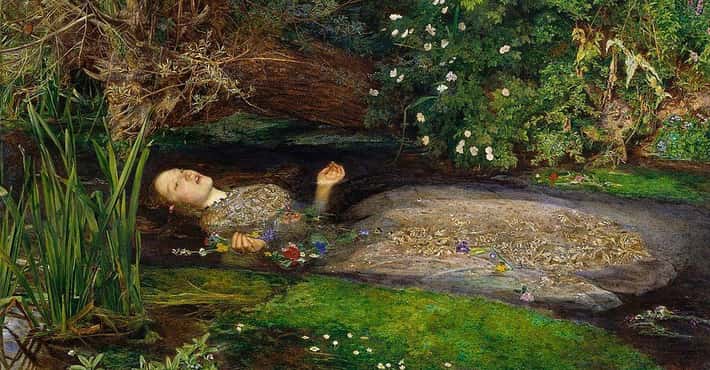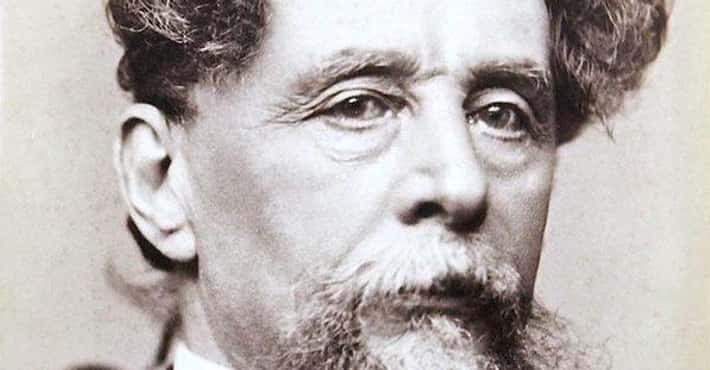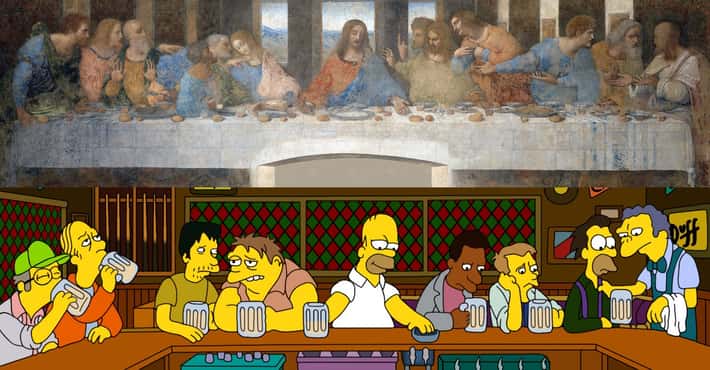The Best Paintings Of All Time
- 13,309 VOTESPhoto: Michelangelo / Wikimedia Commons / Public Domain
The Creation of Adam is a quintessential masterpiece by the Renaissance maestro, Michelangelo Buonarroti. Painted between 1508 and 1512, it forms part of the Sistine Chapel's ceiling frescoes in Vatican City, illustrating a biblical moment from the Book of Genesis where God breathes life into the first man, Adam. This iconic work is revered as one of the best paintings of all time, not only for Michelangelo's revolutionary use of anatomical precision and sublime aesthetics but also for the painting's profound embodiment of the humanistic ideals of the Renaissance period. It captures the divine spark of creation with a touch that has become emblematic of the connection between man and the divine, inspiring awe and wonder for generations. The palpable energy and emotion conveyed through the nearly touching hands of God and Adam have cemented The Creation of Adam as a timeless symbol of artistic and spiritual grandeur.
- 24,114 VOTESPhoto: Vincent van Gogh / Wikimedia Commons / Public Domain
The Starry Night, painted by the post-impressionist Vincent van Gogh in 1889, stands as one of the most recognizable and celebrated works in art history. Created during his stay at the asylum of Saint-Paul-de-Mausole in Saint-Rémy-de-Provence, van Gogh's masterpiece is an emotional portrayal of the night sky as viewed from his window, characterized by swirling clouds, glowing stars, and a tranquil village beneath. The painting is a testament to Van Gogh's innovative use of color and bold, expressive brushwork that became a hallmark of the post-impressionist movement. It is lauded as one of the best paintings of all time for its powerful combination of beauty, emotion, and its ability to capture the imagination, representing a deeply personal reflection of the artist's psyche and his quest for solace through the act of painting. The ethereal and dreamlike quality of The Starry Night continues to captivate viewers, securing its status as a timeless piece of art that resonates well beyond the era of its creation.
- 32,940 VOTESPhoto: Leonardo da Vinci / Wikimedia Commons / Public Domain
The Last Supper, a monumental fresco by Leonardo da Vinci, stands as one of the defining works of the Renaissance period and is widely considered one of the best paintings of all time. Completed in 1498 for the convent of Santa Maria delle Grazie in Milan, it represents the dramatic moment at the Last Supper when Jesus announces that one of his twelve apostles would betray him. Leonardo's mastery is evident in the composition's use of perspective, the arrangement of figures in space, and the emotional intensity and character expressions he captures. The work's innovative approach to grouping the apostles into dynamic clusters and the use of chiaroscuro — the contrast of light and shadow — showcases Leonardo’s profound understanding of human emotion and his skill in conveying narrative through art. The painting's deteriorating condition over time has only amplified its mystical allure and the urgency of preserving this pivotal piece of cultural heritage. Its lasting influence on art, its historical significance for religious narrative, and the technical prowess demonstrated by da Vinci secure The Last Supper's reputation as a masterpiece of Western art.
- 42,964 VOTESPhoto: Russian Museum / Wikimedia Commons / Public Domain
The Ninth Wave, an evocative marine painting by the Russian artist Ivan Aivazovsky, is a luminous showcase of Romanticism and arguably one of the artist's most famous works. Painted in 1850, it depicts a group of shipwreck survivors clinging to a fragment of their broken mast as they are illuminated by the hopeful light of the morning after a tumultuous storm. Aivazovsky's masterful rendering of the sea at its most formidable and majestic—as well as the fragile state of the survivors—captures the power and beauty of nature that Romantic artists often emphasized. The artwork is considered one of the best paintings of all time for its technical brilliance, particularly Aivazovsky's ability to portray the transparency and movement of the waves with such realism that the viewer can almost feel the spray of the sea. Its emotional impact, combined with the painter's profound understanding of light and color, evokes a sense of awe and human vulnerability, leaving a lasting impression on those who view it. Through The Ninth Wave, Aivazovsky solidified his reputation as a preeminent painter of seascapes and his contribution to the Romantic movement.
- 53,000 VOTESPhoto: Johannes Vermeer / Wikimedia Commons / Public Domain
Girl with a Pearl Earring is a renowned work by Dutch artist Johannes Vermeer, created circa 1665. This exquisite piece is often referred to as the "Dutch Mona Lisa" and is emblematic of the Baroque period, celebrated for its rich detail and use of light. The painting portrays a young girl, her eyes bathed in a soft, enigmatic gaze, turning over her shoulder to look at the viewer, with a luminescent pearl earring dangling from her ear. It is considered one of the best paintings of all time for its captivating simplicity and the masterful depiction of the girl's delicate features, which have intrigued art enthusiasts for centuries. Vermeer's ability to convey emotion and character through subtle expression and the meticulous rendering of the effects of light on texture give this artwork its timeless allure and its place in the pantheon of great portraiture. Indeed, the mystery surrounding the subject's identity and the mesmerizing quality of her gaze contribute to the painting's enduring fascination and status as a masterpiece of Western art.
- 62,396 VOTESPhoto: Sandro Botticelli / Wikimedia Commons / Public DomainThe Birth of Venus is a painting by Sandro Botticelli generally thought to have been painted in the mid 1480s. It has long been suggested that Botticelli was commissioned to paint the work by the Medici family of Florence, specifically Lorenzo di Pierfrancesco de' Medici under the influence of his cousin Lorenzo de' Medici, close patron to Botticelli. However, there are no documents associated with the painting, and its first identification with the Medici family only comes in the 1550 edition of Vasari's Lives. It depicts the goddess Venus, having emerged from the sea as an adult woman, arriving at the sea-shore. The painting is on display at the Uffizi Gallery in Florence, Italy.
- Photo: Claude Monet / Wikimedia Commons / Public Domain"The Japanese Footbridge and the Water Lily Pool, Giverny" (1899) is one in a series of water lilies paintings by French Impressionist artist Claude Monet.
- 81,812 VOTESPhoto: Caspar David Friedrich / Wikimedia Commons / Public DomainWanderer above the Sea of Fog, also known as Wanderer Above the Mist, is an oil painting composed in 1818 by the German Romantic artist Caspar David Friedrich. It currently resides in the Kunsthalle Hamburg in Hamburg, Germany.
- 91,934 VOTESPhoto: Rembrandt / Wikimedia Commons / Public DomainMilitia Company of District II under the Command of Captain Frans Banninck Cocq, also known as The Shooting Company of Frans Banning Cocq and Willem van Ruytenburch, but commonly referred to as The Night Watch, is a 1642 painting by Rembrandt van Rijn. The painting may be more properly titled by its long since forgotten name The Company of captain Frans Banning Cocq and lieutenant Willem van Ruytenburch preparing to march out. In the 18th century the painting became known as the Night Watch. It is prominently displayed in the Rijksmuseum, Amsterdam, the Netherlands, as the best known painting in its collection. The Night Watch is a world renowned example of Baroque art.
- 102,454 VOTESPhoto: John William Waterhouse / Wikimedia Commons / Public DomainThe Lady of Shalott is an 1888 oil-on-canvas painting by the English Pre-Raphaelite painter John William Waterhouse in Tate Britain in London, where it is usually on display, in room 1840 in 2013. The work is a representation of a scene from Alfred, Lord Tennyson's 1832 poem of the same name, in which the poet describes the plight of a young woman, loosely based on the figure of Elaine of Astolat from medieval Arthurian legend, who yearned with an unrequited love for the knight Sir Lancelot, isolated under an undisclosed curse in a tower near King Arthur's Camelot. Tennyson also reworked the story in Elaine, part of his Arthurian epic Idylls of the King, published in 1859, though in this version the Lady is rowed by a retainer in her final voyage. Waterhouse painted three different versions of this character, in 1888, 1894 and 1915. According to Tennyson's version of the legend, the Lady of Shalott was forbidden to look directly at reality or the outside world; instead she was doomed to view the world through a mirror, and weave what she saw into tapestry.
- 111,971 VOTESPhoto: Vincent van Gogh / Wikimedia Commons / Public DomainCafé Terrace at Night, also known as The Cafe Terrace on the Place du Forum, is a coloured oil painting executed by the Dutch artist Vincent van Gogh on an industrially primed canvas of size 25 in Arles, France, mid-September 1888. The painting is not signed, but described and mentioned by the artist in three letters. There is also a large pen drawing of the composition which originates from the artist's estate. Visitors of the site can still stand at the northeastern corner of the Place du Forum, where the artist set up his easel. He looked south towards the artificially lit terrace of the popular coffee house, as well as into the enforced darkness of the rue du Palais leading up to the building structure and, beyond this structure, the tower of a former church. Towards the right, Van Gogh indicated a lighted shop as well, and some branches of the trees surrounding the place—but he omitted the remainders of the Roman monuments just beside this little shop. The painting is currently at the Kröller-Müller Museum in Otterlo, Netherlands.
- 122,080 VOTESPhoto: Edward Hopper / Wikimedia Commons / Public DomainNighthawks is a 1942 oil on canvas painting by Edward Hopper that portrays people in a downtown diner late at night. It is Hopper's most famous work and is one of the most recognizable paintings in American art. Within months of its completion, it was sold to the Art Institute of Chicago for $3,000 and has remained there ever since.
- 132,826 VOTESPhoto: Leonardo da Vinci / Wikimedia Commons / Public DomainThe Mona Lisa is a half-length portrait of a woman by the Italian artist Leonardo da Vinci, which has been acclaimed as "the best known, the most visited, the most written about, the most sung about, the most parodied work of art in the world". The painting, thought to be a portrait of Lisa Gherardini, the wife of Francesco del Giocondo, is in oil on a white Lombardy poplar panel, and is believed to have been painted between 1503 and 1506. Leonardo may have continued working on it as late as 1517. It was acquired by King Francis I of France and is now the property of the French Republic, on permanent display at the Louvre Museum in Paris since 1797. The subject's expression, which is frequently described as enigmatic, the monumentality of the composition, the subtle modeling of forms, and the atmospheric illusionism were novel qualities that have contributed to the continuing fascination and study of the work.
- 141,826 VOTESPhoto: Pierre-Auguste Renoir / Wikimedia Commons / Public DomainBal du moulin de la Galette is an 1876 painting by French artist Pierre-Auguste Renoir. It is housed at the Musée d'Orsay in Paris and is one of Impressionism's most celebrated masterpieces. The painting depicts a typical Sunday afternoon at Moulin de la Galette in the district of Montmartre in Paris. In the late 19th century, working class Parisians would dress up and spend time there dancing, drinking, and eating galettes into the evening. Like other works of Renoir's early maturity, Bal du moulin de la Galette is a typically Impressionist snapshot of real life. It shows a richness of form, a fluidity of brush stroke, and a flickering light. From 1879 to 1894 the painting was in the collection of the French painter Gustave Caillebotte; when he died it became the property of the French Republic as payment for death duties. From 1896 to 1929 the painting hung in the Musée du Luxembourg in Paris. From 1929 it hung in the Musée du Louvre until it was transferred to the Musée d'Orsay in 1986.
- 151,929 VOTESPhoto: Katsushika Hokusai / Wikimedia Commons / Public DomainThe Great Wave off Kanagawa, also known as The Great Wave or simply The Wave, is a woodblock print by the Japanese ukiyo-e artist Hokusai. It was published sometime between 1830 and 1833 in the late Edo period as the first print in Hokusai's series Thirty-six Views of Mount Fuji. It is Hokusai's most famous work, and one of the best recognized works of Japanese art in the world. It depicts an enormous wave threatening boats off the coast of the prefecture of Kanagawa. While sometimes assumed to be a tsunami, the wave is, as the picture's title suggests, more likely to be a large rogue wave or okinami. As in all the prints in the series, it depicts the area around Mount Fuji under particular conditions, and the mountain itself appears in the background. Copies of the print are in many Western collections, including the Metropolitan Museum of Art in New York City, the British Museum in London, the Art Institute of Chicago, the National Gallery of Victoria in Melbourne, and in Claude Monet's house in Giverny, France, amongst many other collections.
- 162,142 VOTESThe Persistence of Memory is a 1931 painting by artist Salvador Dalí, and is one of his most recognizable works. First shown at the Julien Levy Gallery in 1932, the painting has been in the collection of the Museum of Modern Art in New York City since 1934 which received it from an anonymous donor. It is widely recognized and frequently referenced in popular culture, though it is commonly better known by the more descriptive titles, 'The Soft Watches' or 'The Melting Watches'.
- 171,477 VOTESPhoto: Jacques-Louis David / Wikimedia Commons / Public DomainNapoleon Crossing the Alps is the title given to the five versions of an oil on canvas equestrian portrait of Napoleon Bonaparte painted by the French artist Jacques-Louis David between 1801 and 1805. Initially commissioned by the king of Spain, the composition shows a strongly idealized view of the real crossing that Napoleon and his army made across the Alps through the Great St. Bernard Pass in May 1800.
- 181,644 VOTESPhoto: Hieronymus Bosch / Wikimedia Commons / Public DomainThe Garden of Earthly Delights is the modern title given to a triptych painted by the Early Netherlandish master Hieronymus Bosch. It has been housed in the Museo del Prado in Madrid since 1939. Dating from between 1490 and 1510, when Bosch was between about 40 and 60 years old, it is his best-known and most ambitious complete work. The triptych is painted in oil on oak and is formed from a square middle panel flanked by two other oak rectangular wings that close over the center as shutters. The outer wings, when folded, show a grisaille painting of the earth during the biblical narrative of Creation. The three scenes of the inner triptych are probably intended to be read chronologically from left to right. The left panel depicts God presenting Eve to Adam, the central panel is a broad panorama of socially engaged nude figures, fantastical animals, oversized fruit and hybrid stone formations. The right panel is a hellscape and portrays the torments of damnation. Art historians and critics frequently interpret the painting as a didactic warning on the perils of life's temptations.
- 191,687 VOTESPhoto: Frederic Leighton, 1st Baron Leighton / Wikimedia Commons / Public DomainFlaming June is a painting by Sir Frederic Leighton, produced in 1895. Painted with oil paints on a 47" × 47" square canvas, it is widely considered to be Leighton's magnum opus, showing his classicist nature. It is thought that the woman portrayed alludes to the figures of sleeping nymphs and naiads the Greeks often sculpted. The Oleander branch in the top right symbolizes the fragile link between sleep and death. The actresses Dorothy Dene and Mary Lloyd, who were depicted in paintings by various Pre-Raphaelite artists, have been variously credited with modelling for the work. Flaming June was auctioned in the 1960s, during a period of time known to be difficult for selling Victorian era paintings, where it failed to sell for its low reserve price of US$140. Afterwards, it was promptly purchased by the Museo de Arte de Ponce in Ponce, Puerto Rico, where it currently resides.
- 201,787 VOTESPhoto: Claude Monet / Wikimedia Commons / Public Domain"Water Lilies" (1916) is one in a series of water lilies paintings by French artist Claude Monet.
- 211,353 VOTESPhoto: Claude Monet / Wikimedia Commons / Public DomainImpression, Sunrise is a painting by Claude Monet. Shown at what would later be known as the "Exhibition of the Impressionists" in April 1874, the painting is attributed to giving rise to the name of the Impressionist movement. Impression, Sunrise depicts the port of Le Havre, Monet’s hometown, and is his most famous painting of the harbor.
- 221,770 VOTESPhoto: Edvard Munch / Wikimedia Commons / Public DomainThe Scream is the popular name given to each of four versions of a composition, created as both paintings and pastels, by the Expressionist artist Edvard Munch between 1893 and 1910. Der Schrei der Natur is the title Munch gave to these works, all of which show a figure with an agonized expression against a landscape with a tumultuous orange sky. Arthur Lubow has described The Scream as "an icon of modern art, a Mona Lisa for our time." Edvard Munch created the four versions in various media. The National Gallery, Oslo, holds one of two painted versions. The Munch Museum holds the other painted version and a pastel version from 1893. These three versions have not traveled for years. The fourth version was sold for $119,922,600 at Sotheby's Impressionist and Modern Art auction on 2 May 2012 to financier Leon Black, the second highest nominal price paid for a painting at auction. The painting was on display in the Museum of Modern Art in New York from October 2012 to April 2013. Also in 1895, Munch created a lithograph stone of the image. Of the lithograph prints produced by Munch, several examples survive.
- 231,087 VOTESPhoto: Jean-François Millet / Wikimedia Commons / Public DomainThe Gleaners is an oil painting by Jean-François Millet completed in 1857. It depicts three peasant women gleaning a field of stray grains of wheat after the harvest. The painting is famous for featuring in a sympathetic way what were then the lowest ranks of rural society; this was received poorly by the French upper classes.
- 241,455 VOTESPhoto: Johannes Vermeer / Wikimedia Commons / Public DomainThe Astronomer is a painting finished about 1668 by the Dutch painter Johannes Vermeer. It is oil on canvas, 51 cm x 45 cm, and is on display at the Louvre, Paris. Portrayals of scientists were a favourite topic in 17th century Dutch painting and Vermeer's oeuvre includes both this astronomer and the slightly later The Geographer. Both are believed to portray the same man, possibly Antonie van Leeuwenhoek. The astronomer's profession is shown by the celestial globe and the book on the table, Metius's Institutiones Astronomicae Geographicae). Symbolically, the volume is open to Book III, a section advising the astronomer to seek "inspiration from God" and the painting on the wall shows the finding of Moses—Moses may represent knowledge and science.
- 251,387 VOTESPhoto: Eugène Delacroix / Wikimedia Commons / Public DomainLiberty Leading the People is a painting by Eugène Delacroix commemorating the July Revolution of 1830, which toppled King Charles X of France. A woman personifying the concept and the goddess of Liberty leads the people forward over the bodies of the fallen, holding the flag of the French Revolution – the tricolour flag, which remains France's flag – in one hand and brandishing a bayonetted musket with the other. The figure of Liberty is also viewed as a symbol of France and the French Republic known as Marianne.
- 261,430 VOTESPhoto: Diego Velázquez / Wikimedia Commons / Public DomainLas Meninas is a 1656 painting by Diego Velázquez, the leading artist of the Spanish Golden Age, in the Museo del Prado in Madrid. The work's complex and enigmatic composition raises questions about reality and illusion, and creates an uncertain relationship between the viewer and the figures depicted. Because of these complexities, Las Meninas has been one of the most widely analyzed works in Western painting. The painting shows a large room in the Royal Alcazar of Madrid during the reign of King Philip IV of Spain, and presents several figures, most identifiable from the Spanish court, captured, according to some commentators, in a particular moment as if in a snapshot. Some look out of the canvas towards the viewer, while others interact among themselves. The young Infanta Margaret Theresa is surrounded by her entourage of maids of honour, chaperone, bodyguard, two dwarfs and a dog. Just behind them, Velázquez portrays himself working at a large canvas. Velázquez looks outwards, beyond the pictorial space to where a viewer of the painting would stand. In the background there is a mirror that reflects the upper bodies of the king and queen.
- 271,190 VOTESPhoto: Jean-Honoré Fragonard / Wikimedia Commons / Public DomainThe Swing, also known as The Happy Accidents of the Swing, is an 18th-century oil painting by Jean-Honoré Fragonard in the Wallace Collection in London. It is considered to be one of the masterpieces of the rococo era, and is Fragonard's best known work.
- 281,129 VOTESPhoto: Pierre-Auguste Renoir / Wikimedia Commons / Public DomainLuncheon of the Boating Party is a painting by French impressionist Pierre-Auguste Renoir. Included in the Seventh Impressionist Exhibition in 1882, it was identified as the best painting in the show by three critics. It was purchased from the artist by the dealer-patron Paul Durand-Ruel and bought in 1923 from his son by Duncan Phillips. It is now in The Phillips Collection in Washington, D.C. It shows a richness of form, a fluidity of brush stroke, and a flickering light.
- 29884 VOTESPhoto: Caravaggio / Wikimedia Commons / Public DomainCaravaggio created one of his most admired altarpieces, The Entombment of Christ, in 1603–1604 for the second chapel on the right in Santa Maria in Vallicella, a church built for the Oratory of Saint Philip Neri. A copy of the painting is now in the chapel, and the original is in the Vatican Pinacoteca. The painting has been copied by artists as diverse as Rubens, Fragonard, Géricault and Cézanne.
- 301,264 VOTESPhoto: Georges Seurat / Wikimedia Commons / Public DomainA Sunday Afternoon on the Island of La Grande Jatte – 1884 is one of Georges Seurat's most famous works, and is an example of pointillism.


